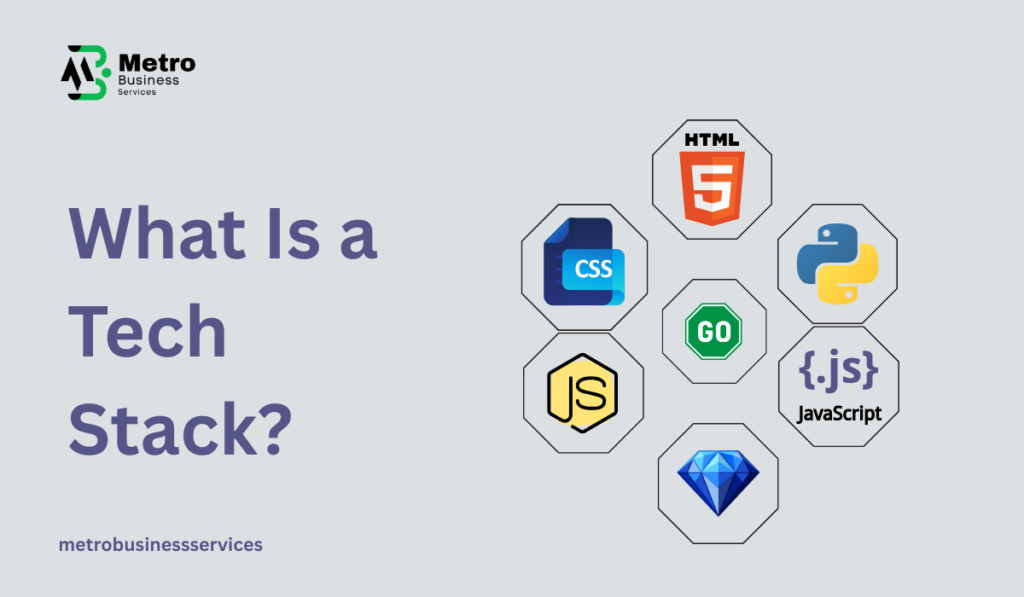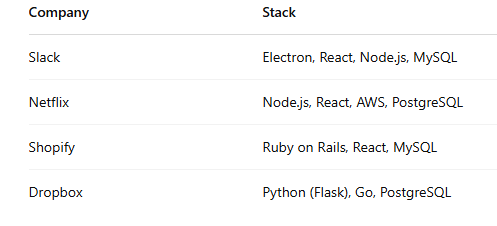In today’s digital-first world, building a scalable and high-performing SaaS product requires more than just a great idea—it demands the right technology stack. From the front-end interface users engage with to the back-end infrastructure powering it all, each component of your SaaS stack plays a vital role in ensuring performance, security, scalability, and maintainability. Choosing the Best Tech Stack for SaaS Web Development is a critical decision. Whether you’re launching your first SaaS web app or looking to upgrade your existing enterprise technology stack, choosing wisely can dramatically impact your success.
What Is a Tech Stack?
A technology stack, often shortened to tech stack, is the combination of programming languages, frameworks, tools, and services developers use to build and maintain software applications. It includes two main layers:

-
Front-End (Client-Side): The interface users interact with, typically built using HTML, CSS, and JavaScript frameworks such as React, Vue.js, or Angular.
-
Back-End (Server-Side): The logic, database, and server infrastructure supporting the application. It might include languages like Python, Node.js, Ruby, or Go, and databases like PostgreSQL or MongoDB.
Understanding the SaaS Technology Stack
A SaaS technology stack is tailored to support Software as a Service (SaaS) products—cloud-based applications accessed via the web. Unlike traditional software, SaaS platforms require stacks optimized for availability, multi-tenancy, data security, and seamless scaling. The SaaS tech stack you choose can shape everything from user experience to your application’s ability to integrate with other services and handle growing traffic.
Key Components of a Modern SaaS Stack
When evaluating your application tech stack, consider how each layer contributes to your product’s overall functionality and performance:
Frontend Frameworks and Libraries
Frontend technologies help build interactive and intuitive user interfaces. Commonly used in SaaS web development:
-
React (by Meta): Lightweight, component-based, and fast.
-
Vue.js: Easy to integrate, flexible, and beginner-friendly.
-
Angular (by Google): Enterprise-ready, robust, and structured.
Backend Stack
The backend tech stack supports business logic, user authentication, payment processing, data storage, and more. Popular options include:
-
Node.js + Express (JavaScript)
-
Django (Python)
-
Ruby on Rails (Ruby)
-
Laravel (PHP)
Databases
Choosing the right database is essential for managing application data. Some top options include:
-
PostgreSQL: Ideal for structured data and ACID compliance.
-
MongoDB: Document-oriented and suitable for dynamic schemas.
-
MySQL: Widely supported and robust.
-
Firebase: Great for real-time apps and rapid prototyping.
Cloud Infrastructure and DevOps
A scalable cloud platform ensures your SaaS can grow efficiently. Common services:
-
AWS, Azure, Google Cloud: Powerful, secure, and scalable.
-
Docker + Kubernetes: For containerization and orchestration.
-
CI/CD tools like Jenkins, GitHub Actions, and GitLab CI/CD.
APIs and Integrations
SaaS web apps often integrate with third-party services like payment gateways, analytics, and CRM platforms. Ensure your stack supports easy API consumption and data exchange.
How to Choose the Right SaaS Tech Stack
Picking the right tools involves more than copying what popular SaaS applications use. Let’s walk through a tech stack analysis that balances technical, business, and operational needs.

Understand Your Product Requirements
-
What are you building? Is it a CRM, eCommerce platform, or an internal dashboard?
-
Who are your users? Enterprises may need complex permission structures, while small businesses prioritize simplicity.
-
What platforms will it support? Desktop, mobile, or both?
Scalability Needs
A scalable tech stack is vital if you expect rapid growth. Stateless microservices, auto-scaling databases, and distributed systems can help your application adapt without degrading performance.
Time to Market
Some frameworks allow quicker development. For instance, Laravel and Ruby on Rails are known for speed and convention over configuration. Use a SaaS product development framework that helps you deliver MVPs fast.
Developer Expertise
Don’t choose the newest SaaS language just because it’s trending. Ensure your team is proficient in the SaaS programming language you select. Otherwise, onboarding and debugging can slow you down.
Security and Compliance
If your top SaaS applications handle sensitive data, your stack must support encryption, role-based access control, and compliance with regulations like GDPR and HIPAA.
Cost Efficiency
Each tool comes with its own licensing, hosting, and maintenance costs. For early-stage startups, a lean and cost-effective tech stack (like Firebase + Vue + Node) can be ideal.
Popular Tech Stack Examples for SaaS
Let’s examine a few technology stack examples used by successful platforms:

If you’re exploring how to build a tech stack, start by mapping your app’s functional requirements, performance expectations, and budget.
Emerging Trends in SaaS Engineering
The industry is shifting fast. Here are some trends in SaaS engineering you should consider:
-
Serverless Architecture: Using AWS Lambda or Azure Functions to scale without managing servers.
-
Jamstack: Separating front-end from back-end via APIs improves performance and security.
-
AI Integration: Many top SaaS apps are using machine learning for personalization and automation.
Best Frameworks for SaaS Applications
When choosing a SaaS product development framework, aim for flexibility, scalability, and community support. Some top picks:
-
Next.js: Ideal for server-side rendering with React.
-
Django: Secure and great for admin-heavy applications.
-
Rails: Mature and well-documented for rapid MVPs.
-
NestJS: Modern, TypeScript-based, scalable for enterprise-grade apps.
Is SaaS the New Application Stack?
Some industry leaders claim that “SaaS is the new application stack,” highlighting the shift from traditional software to cloud-native, subscription-based platforms. This philosophy promotes agility, centralized updates, and seamless integration across the business ecosystem.
Balancing Business Goals with Technical Choices
The right enterprise tech stack should support your business roadmap just as much as your development goals.
Consider:
-
Product-Market Fit: Will the stack help you iterate and release features your users want?
-
Integration with Marketing Tools: Your SaaS marketing tech stack should support CRMs, automation tools, and analytics.
-
Post-Launch Maintenance: Can your team easily maintain and improve the product?
By aligning your proposed tech stack with both user needs and internal capabilities, you future-proof your application.
Real-World Use Case: Choosing a SaaS Stack for a Startup
Imagine you’re launching a CRM for remote teams. You need real-time collaboration, mobile access, and integration with Slack and Zoom.
A solid stack might include:
-
Frontend: React + Tailwind CSS
-
Backend: Node.js with Express
-
Database: PostgreSQL
-
Real-time: Socket.io
-
Cloud: AWS or Firebase
-
Authentication: Auth0
This modern SaaS build ensures you’re ready to scale, pivot, and deliver quickly—perfect for startups.
metrobusinessservices: Your Partner in Scalable SaaS Development
At metrobusinessservices, we help founders and enterprises design and build SaaS products using cutting-edge technologies. Whether you’re launching an MVP or scaling to thousands of users, we guide you through every phase of selecting, implementing, and optimizing your tech stack.
Frequently Asked Questions
What is a SaaS tech stack?
A SaaS tech stack is the collection of front-end and back-end tools, frameworks, and services used to build cloud-based software applications.
Which programming language is best for SaaS development?
Languages like JavaScript (Node.js), Python, and Ruby are popular due to their scalability, ease of use, and strong community support.
How do I choose a backend tech stack?
Consider your project’s size, expected user load, security needs, and team expertise. Common choices include Node.js, Django, and Ruby on Rails.
What are examples of SaaS development tools?
Common tools include Docker, Kubernetes, Postman, GitHub, Firebase, and CI/CD platforms like Jenkins.
Is serverless architecture good for SaaS?
Yes, it enables cost efficiency, auto-scaling, and easier management, especially for small and medium-sized SaaS platforms.
Can I change my tech stack later?
While possible, changing stacks mid-project can be costly. Plan ahead and choose a flexible, future-proof stack early on.
What’s the best front-end framework for SaaS?
React is widely used due to its speed and component-based architecture. Vue.js and Angular are also excellent options.
Should startups use open-source tech stacks?
Yes, open-source stacks reduce costs, offer strong community support, and speed up development—great for early-stage products.
What is the role of APIs in SaaS stacks?
APIs connect your SaaS with external services (e.g., Stripe, Zoom, CRMs), adding functionality without reinventing the wheel.
What is a modern technology stack?
It refers to up-to-date tools and frameworks that support scalability, cloud deployment, and integration—such as React, Node.js, PostgreSQL, and AWS.
Conclusion
Selecting the best tech stack for SaaS web development is a strategic decision that shapes your product’s future. By understanding your business goals, technical requirements, and user expectations, Choosing the Best Tech Stack for SaaS Web Development becomes a guided process to craft a tech foundation that scales, adapts, and succeeds in a competitive market. Remember: trends evolve, but the fundamentals of solid software architecture, team alignment, and customer-centricity never go out of style.

